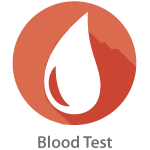Ovarian Cancer
Health Check




Detect problems before they become troubles.
Our first line health checks are specifically tailored to provide a picture of how various aspects of the body is functioning and performing.
Ovarian Cancer is one of the most common causes of cancer related deaths among women worldwide. Ovarian Cancer is often detected at an advanced stage which generally results in poor survival rates, therefore early detection is key to improved survival.
What is the objective of this scan?
Ovarian cancer is a disease that can disrupt the normal function of the ovaries. If it’s left unchecked, it can affect other parts of the body too.
Ovarian cancer occurs when abnormal cells within the ovary start to multiply, creating a tumour. But it’s important to note that not all tumours are cancerous.
Non-cancerous tumours are called benign tumours. This means they don’t usually spread to other parts of the body. They may need treatment but they’re rarely life threatening.
Malignant ovarian tumours are cancerous and can be life threatening.
It’s important to catch cancers early because they can grow large enough to engulf most of the ovary and spread to other parts of the body too.
What are the symptoms of ovarian cancer?
What out for these ovarian cancer symptoms:
- Persistent stomach pain
- Persistent bloating
- Finding it difficult to eat or feeling full quickly
- Needing to empty your bladder more often
Other symptoms you may notice include:
- Back pain
- Changes in your bowel habits (diarrhoea or constipation)
- Feeling tired all the time
If your regularly experiencing these symptoms on most days it’s important to talk to your GP as soon as possible.
To learn more about the symptoms of ovarian cancer you can download ovarian cancer action leaflet.
What is included in this assessment?
The ovarian cancer assessment includes ultrasound scans including transvaginal scan looking at you ovaries along with a special blood test which checks so called cancer markers or biomarkers in the blood that may be produced by some ovarian cancer cells.
What Cancer markers are included?
The blood test part of the assessment measures CA125 & HE4.
Traditionally CA125 marker test is the best known test for ovarian cancer diagnosis, and is the serum marker most widely used to monitor therapeutic response and to detect disease or disease recurrence in patients treated for epithelial ovarian cancer.
Elevated levels of CA125 may indicate you have ovarian cancer however CA125 isn’t specific to ovarian cancer and it can be raised in conditions including endometriosis, fibroids, pelvic inflammatory disease and pregnancy, so a raised CA125 level doesn’t definitely mean you have ovarian cancer.
Recognised limitations have prompted the development of biomarkers with better sensitivity for early stage diagnosis, with the ability to differentiate women with ovarian cancer from those with benign ovarian conditions. CA 125 has a high false positive rate among women with benign gynecological conditions such as endometriosis, fibroids, pelvic inflammatory disease and pregnancy. It is well documented that approximately 20% of ovarian cancers lack expression of CA 125, and levels are not increased in nearly 40-50% of early stage ovarian cancers.
HE4 is a new marker for ovarian carcinoma, which is over-expressed in patients with ovarian cancers. When combined with CA 125, HE4 significantly increases the level of sensitivity for detection of ovarian cancer. HE4 is consistently expressed in patients with ovarian cancer and demonstrates an increased sensitivity and specificity over that of CA 125 alone.
A Risk of Ovarian Malignancy Algorithm (ROMA) classifies patients as being at low or high risk for malignant disease using both CA 125 and HE4 results and a woman’s menopausal status. The risk is given as an adjunct to the two test results for CA 125 and HE4. ROMA calculates a risk of finding ovarian cancer during surgery. ROMA classifies patients as being at low or high risk for malignant disease.
HE4 is CE marked as an aid in estimating the risk of epithelial ovarian cancer in pre-menopausal and postmenopausal women.
What if I have abnormal results?
It is important to take your results to your regular healthcare provider for interpretation. Whilst high levels or abnormal results could mean you have ovarian cancer, this test is not definitive and elevated results could be signs of other problems such as endometriosis, fibroids, pelvic inflammatory disease and pregnancy.
What is Included?
This health check includes a detailed ultrasound scan of the ovaries, uterus, endometrium (lining of the womb) and adnexea (area around the ovaries). Furthermore the blood test looks at the ovarian cancer markers and calculates the risk for malignant disease using CA 125 and HE4 results and a woman’s menopausal status.
A full and comprehensive report of the assessment results is provided.
How do I Prepare for this Test?
- A full bladder is required for the ultrasound scan – Please drink 1 litre of fluid approximately 1 hour before your scheduled appointment and please try your best not to empty your bladder before the examination.
- An transvaginal scan (internal scan) is recommended and may be required.
- You may eat as normal and also maintain your normal medication
What Does The Assessment Involve?
Assessment will involve a consultation to discuss your concerns and problems after which a scan will be performed. During the scan you will be asked to uncover your pelvic area and a small amount of jelly will be placed over your skin. An ultrasound camera will then be placed on top and moved along your pelvis. This will result in a picture appearing on the ultrasound monitor and patient TV which will be translated by a medical ultrasound practitioner.
The examination itself usually lasts around 10-15 minutes and is pain free.
Sometimes you may also require an internal scan. For this scan you will be asked to empty your bladder. You will need to take everything bottom half off and a sheet will be provided to cover yourself with. You will be laying on your back and a camera will be placed inside your vagina which will be moved around to obtain information. This procedure is usually pain free however occasionally you may experience some discomfort. You will be able to pause or stop this procedure at any time if you feel the need to.
At the end of the examination a brief explanation of the results may be offered. A formal ultrasound scan report with any recommendations will be sent to you which you can take to your regular healthcare professional.
This blood test is just like a standard blood test. Once the procedure is complete a small plaster will be placed onto the site which can be removed after a few hours.
Note:
- This scan requires access to the area of interest, therefore it is recommended to wear loose clothing to facilitate this process.
- Internal scanning may be required.
- We will also require details of your GP / Health Care Professional, which may be requested prior to or at the time of the scan.
- Study images may be available at an additional charge – more information and to request this can be found by clicking here.
- Please bear in mind that we will endeavor to book both your blood test and scan at the same appointment however this may not always be possible.
All of our first line ultrasound scans and health checks are optional. You must be at least 16 years old and you should have no existing medical condition or treatment pending that relates to the procedure you are booking. If you are in any doubt about having any type of procedure, you should consult your GP.
Regular Price
£329
Deposit Required At Booking.
Terms and Conditions apply.
.
Call Me Now